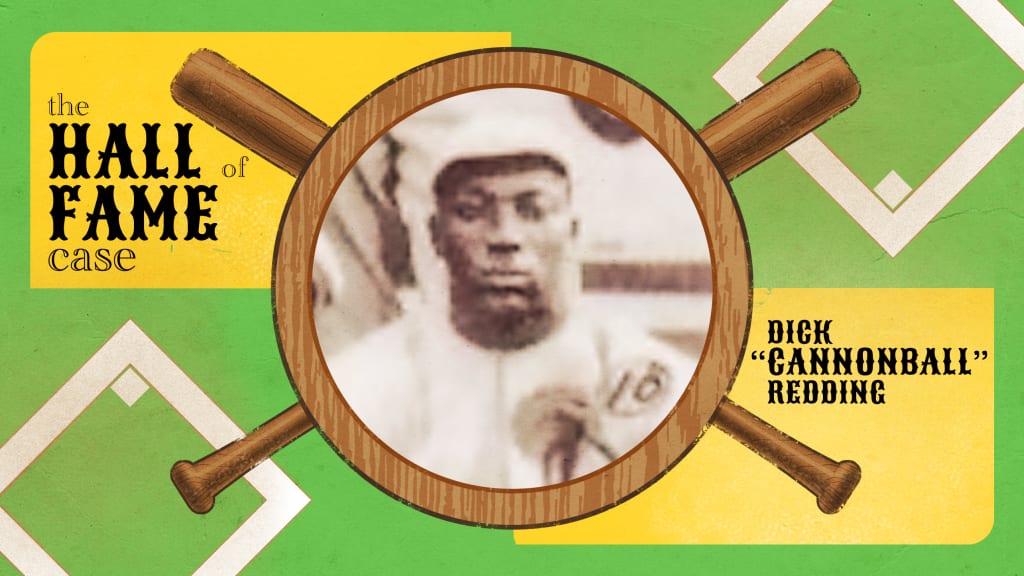
On Dec. 5, the Hall of Fame’s Early Baseball Era Committee (pre-1950) and Golden Days Era Committee (1950-69) will meet to vote on 10-player ballots, with the results announced live on MLB Network that night at 6 p.m. ET. We're here to offer a primer on the 20 players who are up for consideration. Click here to view the other posts.
Name: Dick "Cannonball" Redding
Years: 1911-31, '36
Career stats:
Negro Leagues (1923-27): 9-21, 4.43 ERA, 247 2/3 IP, 107 K, 66 BB
Other Black Baseball Leagues: 92-49, 2.60 ERA, 1,229 1/3 IP, 763 K, 364 BB
BIO: Ignore the numbers, because the numbers don't add up to what Dick "Cannonball" Redding meant to the sport. They also represent only a fraction of his career and don't capture every appearance, every barnstorming game and every dominating performance that earned him fame and renown from fans and opponents alike. Quite simply: Cannonball Redding is still more of a tall tale, a legend based on newspaper reports and the people who played against him.
Born in Atlanta, Ga., on April 15, 1890, Redding quickly showed off the blazing heater that earned him his moniker while playing with the semi-pro Atlanta Deppins. He then made his professional debut in 1911 and pitched briefly with the Philadelphia Giants before joining the New York Lincoln Giants later that year. It's 1912 when his legend really began. Newspaper accounts claim he went 43-12 with seven no-hitters that season, as Redding dominated in nearly every appearance while the Lincoln Giants barnstormed around the country. He even struck out 25 batters -- facing only 27 -- in a victory that season. His fastball was an unhittable blur and batters could simply wave their bats past it.
"Dick Redding was like Walter Johnson. Nothing but speed. That's the reason they called him Cannonball," his teammate Frank Forbes said in 1914. "He just blew that ball by you. I've seen Redding knock a bat out of a man's hand."
He won the World Series with the Lincoln Giants in 1914, leading the team to victory with three wins in the championship. He pitched for a handful of teams -- all of them among the biggest in the sport -- and spent his winters dominating in Cuba. He later became a player-manager, who signed Buck Leonard on a hunch. He made his final appearance out of the bullpen in 1936 when his fastball was but a memory of what it once was, but still people delighted in seeing him on the mound.
And that, more than anything that appears in the official record, is the story of Redding's incredible career. He once appeared in an exhibition event with Ty Cobb -- with Cobb pulled when Redding entered the game. In the end, it was Redding who stole the show, as he struck out 11 of the 12 batters he faced. The Norwich, Conn., Bulletin wrote that Redding, “was given a great ovation by the crowd to whom he proved much more of an attraction than the high salaried Cobb.”
Redding struck out Ruth three times on just nine pitches in another exhibition -- proving that were he allowed to pitch at the Major League level, he would have succeeded. He defeated the Boston Braves and the New York Giants, and out-pitched Carl Mays in a 15-inning game, emerging with a 2-1 victory.
And this was still all just on the strength of Redding's heater, a pitch that was so blisteringly fast he seemingly didn't need any other offerings until years later when he finally added a devastating "hesitation pitch."
NOTABLE STATISTIC: 30. That's the number of no-hitters that Redding reportedly threw. That most likely doesn't include this one that Negro Leagues researcher Gary Ashwill discovered as the first known Negro Leagues' no-hitter in 1912. That day, Redding defeated José Méndez, whom Ashwill called "at that point, the most accomplished and most famous pitcher outside the Major Leagues."
BEYOND THE NUMBERS: Redding's Hall of Fame case exists entirely beyond the realm of recorded numbers. He was barred from Major League Baseball and so was forced to spend his career barnstorming, playing games beyond the purview of detailed box scores and scrutinized statistics. But Redding impressed in every chance he had against big league talent and his contemporaries all were glowing in their support of him.
Cumberland "Cum" Posey, the long-time owner of the Homestead Grays, ranked Smokey Joe Williams and Redding first and second on his all-time All-Black team, with Satchel Paige in third. Catcher Yank Deas, a teammate of Redding's with the Bacharach Giants, said that Ruth once told Redding, "if he was a white man how far he'd go in baseball." Legendary manager Casey Stengel told Redding that if he was on a team in the Majors, "You wouldn't lose any games at all."
He was included on the Second Team of the best Negro Leaguers in history by the Pittsburgh Courier in 1952. In 1971, the New York Daily News pegged him as one of 12 Negro League players most likely to be inducted into the Hall from that year's committee tasked with honoring Negro League players. Since then, the other 11 -- Cool Papa Bell, Oscar Charleston, Ray Dandridge, Martín Dihigo, Josh Gibson, Monte Irvin, Judy Johnson, Buck Leonard, Pop Lloyd, Paige and Williams -- have all gained entrance into the Hall of Fame. Redding is the only one still on the outside looking in.
Hall of Famer Ben Taylor, a friend and opponent of Redding's, said, "His name should go down in history as one of the greatest pitchers of all-time."
It's been over a century since Redding was born and 85 years after he took the mound for the last time in his career. And yet Redding's legendary fastball still lives on.
